Monarch butterflies have left their roosts in Mexico and will be arriving in the “Texas Funnel,” which includes San Antonio and the Hill Country in the next few weeks. Those tracking their great migration through Texas to Canada in 2018 will see nearly 15% fewer butterflies start the long, multigeneration journey.
The winter roosting populations declined 14.7% over the previous year, World Wildlife Fund officials announced. The iconic orange-and-black insects’ occupied only 6.12 acres at this year’s winter roosts in the Mexican mountains. The population is far below the 14.82 acres goal set by the 2017 Monarch Conservation Implementation Plan.
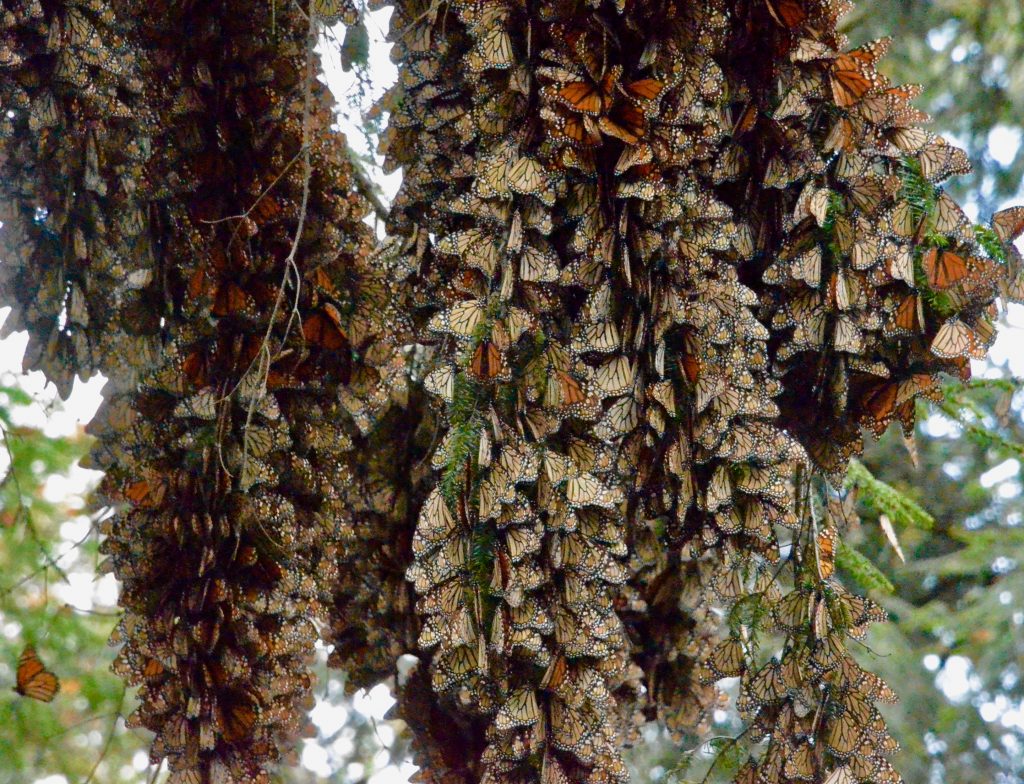
What impacts would a copper mine have on Monarch roosting sites in Angangueo, Michoacán? Photo copyright Veronica Prida
During peak migration years in the late 1990s, the monarch butterfly population occupied about 44 acres of forest. NOTE: Scientists calculate the population numbers by measuring the amount of forest occupied by overwintering monarchs.
In explaining the decline in monarch numbers, WWF officials blamed climate change–specifically, warming weather and a freak sleet storm that occurred in early 2017.
In 2016, a spring storm clobbered the forest, removing at least 100 acres of Oyamel firs whose evergreen foliage provides an insulation blanket for the butterflies during the cold winter months. The storm also decimated at least 50 million butterflies just as overwintering monarchs began their 2017 migration north. This contributed to the shortfall, officials said.
“These climate phenomena without a doubt have an impact on the migration,” said Jorge Rickards, director of the World Wildlife Fund in Mexico, at a press conference earlier this week. The organization participates in the annual study that takes the butterfly census.
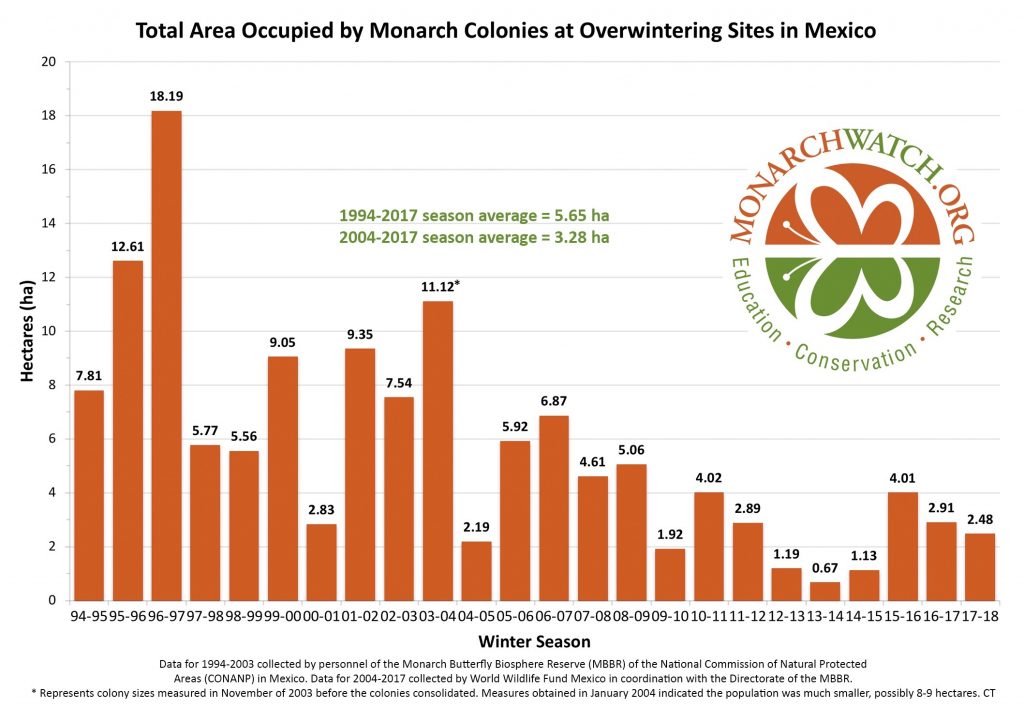
Warming temperatures raise concerns at the roosting sites and throughout the butterflies’ migratory range. Hotter temperatures cause the butterflies to burn through their stored winter fats, since they are more inclined to leave the warmth of the trees in which they roost and seek nectar and water. This can result in an energy shortage when spring migration time arrives.
A changing climate can also effect the availability of the butterflies’ host plant, milkweed. If the weather warms too early and too quickly, the milkweeds don’t have time to sprout the leaves that will attract monarchs’ egg laying. The butterflies will keep moving north–and possibly perish before reproducing.
Warmer weather will likely continue. The National Weather Service Climate Prediction Center said in its mid February 90-day outlook bulletin that Texas, typically the first stop for migrating monarchs, has a 60-70 percent probability of “higher than average”
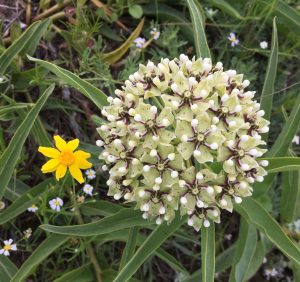
Antelope horns milkweed, a monarch butterfly host plant, awaits monarchs in April 2016. Photo by Monika Maeckle
temperatures this spring. In San Antonio, SAWS, the local water utility lauded for its conservation efforts, speculated at a recent community conservation meeting that Texas will enter another drought this summer and suggested Stage One lawn watering restrictions will be implemented by late March.
Wildflowers, important nectar fuel stops for monarchs and bees, are likely to put on an “average” show this year, according to the Ladybird Johnson Wildflower Center. Andrea Delong-Amaya, director of horticulture, said bluebonnets and other wildflowers may be smaller in size because of a lack of rain, and that it’s too early to determine regional milkweed availability.
In Mexico, monarch butterfly conservationists reported early departures from the spring roosting sites. “The news was early, but it was sudden and certain,” read the Journey North weekly monarch migration update this week. “On March 3rd, two substantial sightings were reported north of the sanctuaries.”
“Millions of monarchs are now en route to northern Mexico and Texas,” wrote Ellen Sharp, co-owner of J&M Butterfly BnB in Macheros, situated near the entrance of Cerro Pelón, a sanctuary to 30% of this year’s monarch butterflies. Sharp wrote the butterflies “seemed confused” by warm temperatures.
Apart from climate change, pesticide use, illegal logging and habitat loss, the Americas’ favorite insect may soon face yet another threat. Reports suggest Grupo Mexico, a $500 billion mining concern traded on the Mexican Stock Exchange under the ticker symbol GMEXICOB, will reopen a long shuttered copper mine at El Rosario, the most freqently visited of the monarch sanctuaries. Grupo Mexico, WWF, and CONABIO, Mexico’s Commission on National Biodiversity, all declined repeated requests for clarification on the status of the copper mine.
Grupo Mexico has stated for years that since the mine operated until 1992 in Angangueo, Michoacán, and technically never closed, it should be allowed to reopen–despite protections put in place for the Monarch Butterfly Biosphere Reserve. The reserve was inscribed as a World Heritage site by UNESCO in 2008.
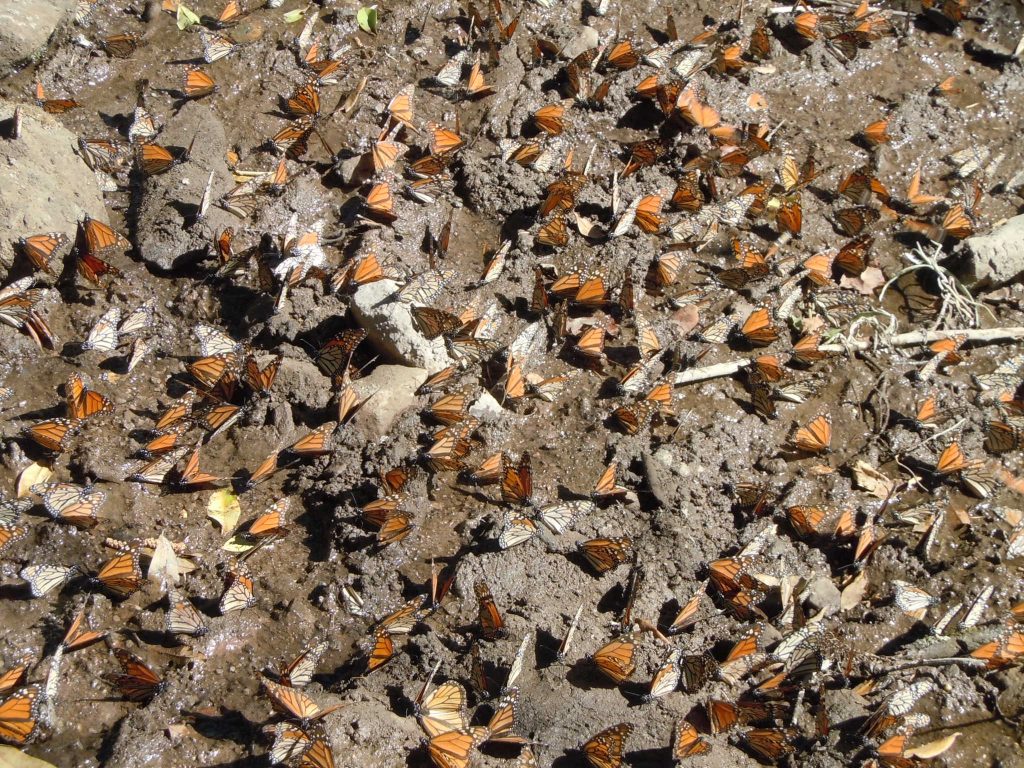
On hot days, monarch butterflies puddle on mountain seeps. Photo by Monika Maeckle
Details of the mine’s reopening have not been disclosed publicly, but locals and visitors report the copper mine is due to restart. “I haven’t heard anything new about the mine—just that it’s happening,” said Ellen Sharp.
Eleonor Briggs, a wildlife photographer who lives in New Hampshire, returned from the area recently and said that a WWF official told her the mine is on track to reopen. “He said not to worry since this was only a ‘small’ reopening for two years and then they would shut for good,” said Briggs. She also was told an ore reprocessing plant will be built in the town to extract the copper.

Grupo Mexico website
Grupo Mexico lists Angangueo as a future mining project on its website. The company website also touts a reputation for “lowest extraction costs in the industry” and status as member of the Mexican Stock Exchange’s Sustainable IPC index, a financial indicator that acknowledges the companies with the highest commitment to social responsibility, environmental performance, and corporate governance.
In 2014, the company was responsible for the worst mining accident in Mexican history. At a mine in Buenavista in the northern state of Sonora, Mexico, the incident left dozens of miners to die underground after methane explosions. It also spilled 10 million gallons of copper sulfate acid into the Sonora and Bacanuchi rivers, 25 miles south of the U.S. border with Arizona, leaving 24,000 people without clean water.
Copper mining and processing use huge amounts of water, create problematic waste, and impact water quality, soil quality and ecosystem loss and vegetation. The implications are huge for a forest stressed by drought and a migration taxed by climate change.
Related posts:
- Monarch butterfly migrating population drops 27%, freak sleet storm to blame
- How to track the monarch butterfly migration from your desk
- Monarch butterfly and Pollinator Festival set October 20 -22 in San Antonio
- Butterfly bonanza: Monarch netted on Llano River tagged in Oklahoma
- How to Tag a Monarch Butterfly in Six Easy Steps
- What does climate change mean for Monarch butterflies?
- New study: late season nectar plantsmore important than milkweed to Monarch migration
- Should You Bring in a Late Season Caterpillar into Your Home?
- How to Tell Queens from Monarchs
- How to Raise Monarch Butterflies at Home (First of Two Parts)
- Coming soon: Grupo Mexico copper mine in heart of Monarch butterfly roosting sites?
- Will the Monarch Migration Become Extinct?
Like what you’re reading? Follow butterfly and native plant news at the Texas Butterfly Ranch. Sign up for email delivery in the righthand navigation bar of this page, like us on Facebook, or follow us on Twitter, @monikam.

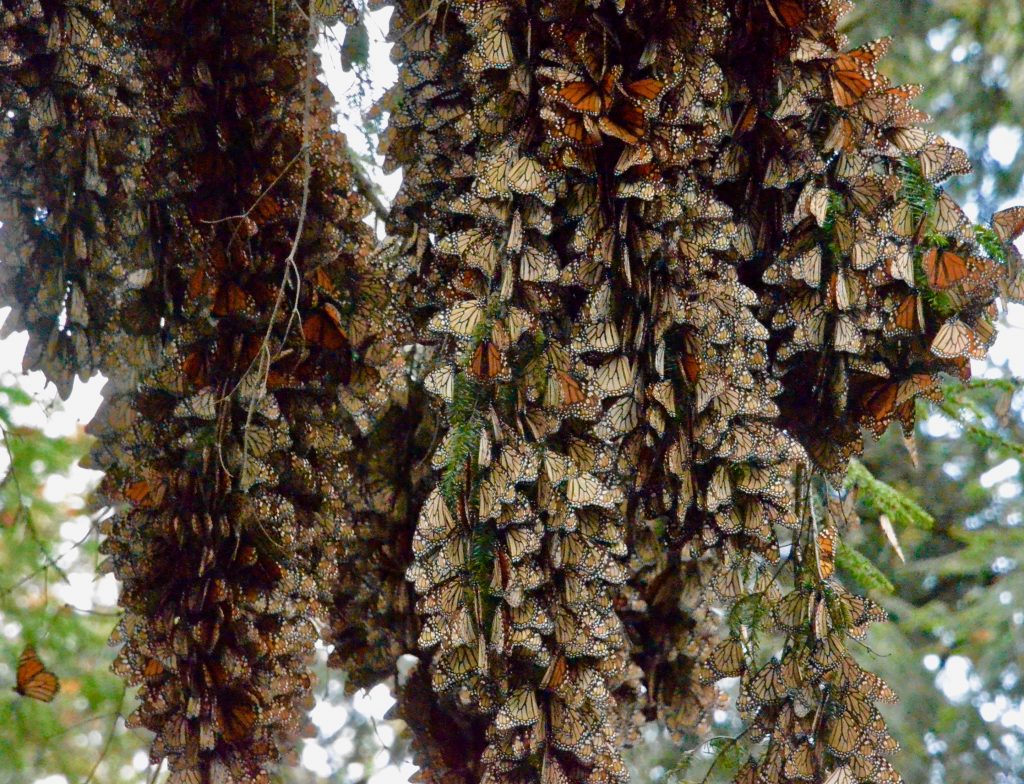
This reminds me of Barbara Kingsolver’s book Flight Behavior which supposes that the Monarch migration stops in the Ozarks because of global warming. If you haven’t read it, I highly recommend you do!
Yup-a page turner.
I met Eleanor Briggs at Ellen and Joel’s place when I was in Mexico a couple of weeks ago. We were staying at the same hotel (not the B&B). She asked to purchase my book and we had a lovely conversation. She’s a fascinating woman!
Back in early September it was evident that the fall migration would be relatively modest in size: http://imagizer.imageshack.us/a/img922/4379/DPHaMU.jpg Between 2001-2009 upper midwestern corn and soybean farmers gradually eliminated weeds (including milkweed) that used to grow in their fields so it’s not surprising the overwintering population in Mexico dropped during that time frame as can be seen in this graph: http://imagizer.imageshack.us/a/img922/3900/K4aRxY.jpg . But since about 2009 there has not been much additional substantial loss of milkweed in the eastern and central USA so it’s not surprising that the population in Mexico has been stable since then. If there is future warming at the monarch overwintering grounds in central Mexico, it is reasonable to expect the coniferous forests and monarchs will move uphill. There’s plenty of uphill room for more forest and monarchs on the 17,000 foot Popocatepetl and 15,000 foot Nevado de Toluca volcanos. Millions of monarchs are already using the overwintering forest on the Popocatepetl volcano: https://imageshack.com/a/img924/4691/yq6NO6.jpg http://imagizer.imageshack.us/a/img924/2919/nrOq7e.jpg https://imageshack.com/a/img924/5404/zmN3JE.jpg